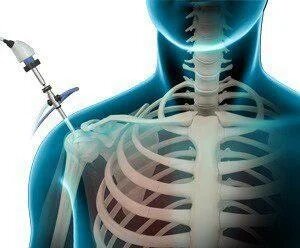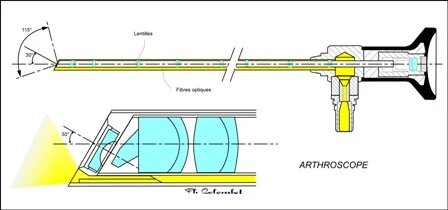Shoulder arthroscopy
What's this ?
 Arthroscopy is part of endoscopy. This term includes all techniques using an optic capable of seeing inside the body. Arthroscopy is therefore a form of endoscopy intended for the joints only.
Arthroscopy is part of endoscopy. This term includes all techniques using an optic capable of seeing inside the body. Arthroscopy is therefore a form of endoscopy intended for the joints only.
Today, the surgeon may decide to create a space to allow the camera to have access (extra-articular endoscopy), for example around the tendons (tendinoscopy).
What does an arthroscope look like?

The arthroscope is a tube of 2, 3, 5 or 7 mm in diameter in which there are lenses. This tube contains a fiber optic cable connected to a light source to illuminate the inside of the body as well as a pipe allowing a jet of physiological saline to pass through to clean.
principle
Initially used for diagnostic purposes, arthroscopy is currently essentially operative, i.e. it allows surgical procedures to be performed without significant opening. The operation is performed under general or locoregional anesthesia in the operating room.
At least two incisions are necessary, one to receive the arthroscope and the other to pass the mini surgical instruments. In general, the incisions are barely larger than the diameter of the arthroscope. They are so small that they do not necessarily generate a suture and can close on their own.
Depending on the type of intervention, it is also likely that the surgeon will intervene in different areas and have to incise elsewhere, but the technique is always very respectful of the human body. It allows observation and certain interventions in the articular cavity (ligaments, cartilages, tendons). Today a large number of traditional techniques (known as “open sky”) can be performed under arthroscopy.
Arthroscopy or open surgery?
Arthroscopy avoids the morbidity associated with lesions created by the incision needed for open surgery and, if the surgeon decides to repair, very few stitches will be required
The arthroscopic technique makes it possible to directly reach the area to be treated, the flesh, the veins, the bones, are only crossed if it is useful. Convalescence is therefore generally shorter.
The anesthesia is also of shorter duration than during an open surgery, the operating time being reduced by the less important suturing time.
Finally, it often happens that to treat a joint it is necessary to reach a specific area by two different and opposite approaches. However, arthroscopy allows the surgeon to reach, most of the time, as many areas as necessary.
Type of anesthesia
The type of anesthesia chosen will be specified to you in consultation but may be adapted according to the immediate pre-operative circumstances.
Déroulement
During shoulder arthroscopy, three to five incisions will be necessary to explore your lesions and repair them. Depending on the lesions discovered, additional incisions are always possible and the repair planned under arthroscopy can sometimes be completed by open surgery during the same operating time (mini open) or deferred, depending on your surgeon's decision due to discovered lesions.
The post-operative
In the immediate post-operative period, your arm will be immobilized at the elbow at 90°, in a simple sling, for a period of three weeks. The evening of your operation, your surgeon will come to check in your room that everything is going well. Analgesic treatments will be given to you by the nurse according to the prescriptions and your request. Rehabilitation only begins after 10 days or 3 weeks depending on the pain. Strict immobilization is necessary for three weeks. Only elbow flexion-extension movements will be authorized as well as elbow to body rotation movements, without ever reaching the pain threshold. at home and worn at night and for going out. No arm elevation movement should be performed for a period of 45 days, at the risk of tearing the repaired tendon apparatus.